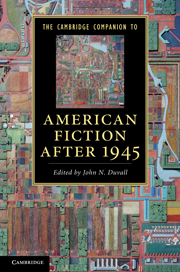Book contents
- Frontmatter
- Introduction: A story of the stories of American fiction after 1945
- PART I POETICS AND GENRES
- PART II HISTORICAL AND CULTURAL CONTEXTS
- 6 African American fiction
- 7 American Indian fiction
- 8 Multiethnicities: Latino/a and Asian American fiction
- 9 American Jewish Fiction
- 10 Feminist fiction
- 11 Southern fiction
- 12 Fiction and the Cold War
- 13 Fiction and 9/11
- PART III MAJOR AUTHORS
- Conclusion: Whither American fiction?
- Index
- Cambridge Companions to …
7 - American Indian fiction
from PART II - HISTORICAL AND CULTURAL CONTEXTS
Published online by Cambridge University Press: 28 March 2012
- Frontmatter
- Introduction: A story of the stories of American fiction after 1945
- PART I POETICS AND GENRES
- PART II HISTORICAL AND CULTURAL CONTEXTS
- 6 African American fiction
- 7 American Indian fiction
- 8 Multiethnicities: Latino/a and Asian American fiction
- 9 American Jewish Fiction
- 10 Feminist fiction
- 11 Southern fiction
- 12 Fiction and the Cold War
- 13 Fiction and 9/11
- PART III MAJOR AUTHORS
- Conclusion: Whither American fiction?
- Index
- Cambridge Companions to …
Summary
While World War II offers a convenient dividing point for mainstream American literature and is often used as a breaking point between modernism and postmodernism, 1945 does not have the same import in the history and development of American Indian fiction. For American Indian literature, the most important milestone comes in 1969, the year that N. Scott Momaday won the Pulitzer Prize for his first novel, House Made of Dawn (1968). To be sure, there were accomplished American Indian authors writing in English in the twentieth century who preceded Momaday, and many of those earlier narrative works were not critically recognized until the postwar period (D'Arcy McNickle's 1936 novel The Surrounded, for instance, or Ella Cara Deloria's novel Waterlily, which was completed in the 1940s but not published until 1988). But this chapter focuses on the outpouring of American Indian fiction since 1968 to provide an overview of some of the key writers and developments of this remarkable period.
In approaching Native literary texts, one must keep in mind that social, cultural, and historical contexts are crucial. Federal policies concerning Indian affairs and indigenous responses to those policies influence the themes and forms of works by American Indian writers. Popular culture matters as well: the antiwar and countercultural movements of the 1960s and 1970s, for instance, led to increased interest in Native peoples and texts as middle-class whites sought out alternative cultures and spiritual lifeways.
- Type
- Chapter
- Information
- The Cambridge Companion to American Fiction after 1945 , pp. 99 - 113Publisher: Cambridge University PressPrint publication year: 2011



